Developing a Project â From Concept to Completion - Ecb - England ...
Developing a Project â From Concept to Completion - Ecb - England ...
Developing a Project â From Concept to Completion - Ecb - England ...
- No tags were found...
Create successful ePaper yourself
Turn your PDF publications into a flip-book with our unique Google optimized e-Paper software.
<strong>Developing</strong> a <strong>Project</strong><strong>From</strong> <strong>Concept</strong> <strong>to</strong> <strong>Completion</strong>www.ecb.co.ukSources of Grant Aid and Funding for Cricket Clubs 1
Contents<strong>Developing</strong> a <strong>Project</strong> – <strong>From</strong> <strong>Concept</strong> <strong>to</strong> <strong>Completion</strong>SectionPageIntroduction 11 Geting Started 22 <strong>Project</strong> Development Team 23 Successful Clients 34 Getting Support 45 Local Communities 46 Consultant Services 57 Technical Compliance 98 RIBA Design Work Stages 99 Planning Consent 1010 Competitive Tendering 1111 Tender Analysis 1212 FFU Contact Details 1313 Design Work Stages 14When embarking on the development of a facilityproject, careful consideration and planning is required<strong>to</strong> ensure the final product meets the original concept.The purpose of this document is <strong>to</strong> set a clear projectdevelopment methodology in taking any new facilityfrom concept <strong>to</strong> completion.This document will assist any type of facility projectmeeting the requirements of potential partners/fundersand the aspirations of people engaged as deliverersof sport.“<strong>Developing</strong> a <strong>Project</strong>” provides advice and guidancewith a series of useful links and contacts <strong>to</strong> supportyou throughout the process. The document has beenwritten in conjunction with the <strong>England</strong> and WalesCricket Board’s Funding Programmes Guidance Noteswhich are available <strong>to</strong> download fromwww.ecb.co.uk/funding2 Sources of Grant Aid and Funding for Cricket Clubs<strong>Developing</strong> a <strong>Project</strong> – <strong>From</strong> <strong>Concept</strong> <strong>to</strong> <strong>Completion</strong> 1
1 Getting Started3 Successful ClientsThink about the aims of your project andways <strong>to</strong> accommodate the current andfuture needs of the club/organisation,including how often the facility will beused on a weekly and seasonal basis.It is important that you consult withinyour membership as widely as possibleabout the aims and objectives of yourclub/organisation.2<strong>Project</strong> Development TeamThe Commission for Architectureand the Built Environment (CABE)publication “Creating ExcellentBuildings” describes how <strong>to</strong> be asuccessful client.Each development project is unique,with special local conditions for site, usepatterns and social context. However,all projects need well structured projectmanagement and can benefit from theten key ways the client can help achievedesign quality.1. Provide strong client leadership4. Develop and communicate aclear brief5. Make a realistic financialcommitment fromthe outset6. Adopt integrated processes7. Find the right people for the job8. Respond and contribute <strong>to</strong> thecontext9. Commit <strong>to</strong> sustainability10. Sign off all key stagesIt is strongly recommended that youform a project development team andappoint a team leader who shouldremain consistent throughout theduration of the project. The project teamshould consist of individuals with skillsets that are relevant and appropriatefor the project.When forming the project team, donot limit its composition <strong>to</strong> the club/organisation members unless themembers can clearly evidence thatthey have the relevant experience andqualifications <strong>to</strong> compliment the plannedproject work.remove themselves from the committeeuntil the completion of the project.The project team should be establishedprior <strong>to</strong> starting any design work andremain operational until final completionof the works. NB: the size and skill setsrequired <strong>to</strong> drive the project may changethroughout the lifespan of the works.2. Give enough time at the right time3. Learn from your own and othersuccessful projectsAll work stages require sign-off so allowtime <strong>to</strong> review the drawings and reportsprepared by the design team, carefullychecking your requirements against thedesign.It should be noted if a member of theclub/organisation is engaged <strong>to</strong> carryout any works on the project and theyare current members of the committee,this would be seen as a conflict ofinterests. Therefore, any members whofind themselves in this position should2 Sources <strong>Developing</strong> of Grant a <strong>Project</strong> Aid – and <strong>From</strong> Funding <strong>Concept</strong> for Cricket <strong>to</strong> <strong>Completion</strong> Clubs<strong>Developing</strong> Sources of a Grant <strong>Project</strong> Aid – and <strong>From</strong> Funding <strong>Concept</strong> for <strong>to</strong> Cricket <strong>Completion</strong> Clubs 3
4Getting Support6Consultant ServicesThe ECB Funding and FacilitiesUnit (FFU) should be your first poin<strong>to</strong>f call for advice. You should makecontact with the FFU during work stageA, as outlined in section 8, and showthem your project (refer <strong>to</strong> contactspage 13). Consulting the ECB at theearliest opportunity allows their input <strong>to</strong>be more valuable.5Local CommunitiesGood communication with the localcommunity is important. Potentially itcould lessen objections <strong>to</strong> your planningapplication and help <strong>to</strong>wards a smoothrelationship with neighbours before,during and after construction. Peoplecan be sensitive <strong>to</strong> change so it’sworth finding ways <strong>to</strong> keep neighboursinformed. This could have surprisingand beneficial results, for example oneFunding and planning permission aretwo important hurdles in the preparationand design stages of a project. The ECBRegional Funding and Facilities Managerwill assess the proposals for technicalcompliance, sports development andfinancial affordability.club arranged temporary contrac<strong>to</strong>r’saccess through adjacent land whichmade larger deliveries possible andshortened the construction period.Good links with the local communityalso provides the opportunity <strong>to</strong> makecontact with new members. One way ofcommunicating is <strong>to</strong> develop a masterplan of the site inclusive of all your futureplans (see example below).If the appropriate skills are not availablewithin the project team, you may need<strong>to</strong> engage the services of specialists,as follows:Building <strong>Project</strong>s (including renovationand refurbishments)1 ArchitectArchitects design new buildings,the spaces around them andalterations <strong>to</strong> existing buildings.They also advise on the res<strong>to</strong>rationand conservation of old buildings,layouts for groups of buildingsand most of what is referred <strong>to</strong> asthe built environment. They liaisewith current users, clients, andconstruction specialists and theirdesigns take account of informationabout cost, safety and socialfac<strong>to</strong>rs from other specialists inthe team. They advise clients onthe practicality of building projectsand seek permission and approval<strong>to</strong> see if the proposals can be putin<strong>to</strong> practice. Once building startsthey can coordinate and administerthe building contract through<strong>to</strong> completion. Refer <strong>to</strong> RIBACommissioning Architecture leafletand websitewww.architecture.com/UseAnArchitect.2 Structural EngineerStructural engineers design andcalculate the building structure andfoundations. They sometimes alsodesign below ground drainage.Refer <strong>to</strong> www.istructe.org3 Mechanical and Electrical (M&E)Services EngineerM&E services engineers design andcoordinate the services of buildingsincluding gas, electricity, heating,lighting, ventilation, water andrenewable energy. They sometimesalso design the drainage. Theycalculate the proposed energy useof the buildings.Refer <strong>to</strong> www.cibse.org4 Quantity SurveyorQuantity surveyors measure,estimate and advise on the cost ofthe designs produced by architects,structural engineers and servicesengineers. www.RICS.org5 Construction DesignManagement(CDM) Coordina<strong>to</strong>rCDM coordina<strong>to</strong>rs advise clients onhealth and safety issues, risks andthe competency of the design team.This is applicable across all projectthemes. They must be appointed bywork stage C/ concept design, asoutlined in section 8.4 <strong>Developing</strong> a <strong>Project</strong> – <strong>From</strong> <strong>Concept</strong> <strong>to</strong> <strong>Completion</strong><strong>Developing</strong> a <strong>Project</strong> – <strong>From</strong> <strong>Concept</strong> <strong>to</strong> <strong>Completion</strong> 5
6 Consultant Services (continued)6 Consultant Services (continued)6 Other SpecialistsSome projects might alsorequire further specialist inputduring the design stage whichwill become apparent during thepreparation stage:• Heritage and conservationspecialists advise on preservinghis<strong>to</strong>ric buildings and res<strong>to</strong>ration.• Highways engineers design andadvise on new roads or alterations<strong>to</strong> the public highways.• <strong>Project</strong> managers takeresponsibility for planning andfacilitating a project. They can ac<strong>to</strong>n the client’s behalf providingadvice and be given responsibilityfor making key decisions.Fine Turf <strong>Project</strong>sAs this type of work carries high levelsof risk regarding climate and tighttimescales, ECB advises that extremelytight control of all phases of work ismaintained by a qualified professional.• Access consultants advise ondesigning inclusive buildings forpeople of all abilities.• Environmental consultantsand ecologists advise onenvironmental issues which mightbe required if the site is a naturalhabitat for protected species.• Landscape architects design thespaces and landscape around thebuildings including details for hardand soft areas, trees and pitches.• Planning consultants providespecialist advice when preparingplanning submissions or appealsin areas with sensitiveplanning issues.Fine Turf <strong>Project</strong>s (including newconstruction and renovations) andNon Turf <strong>Project</strong>sThe design, construction and projectmanagement of new facilities requiresspecialist consultants who in turnhave access <strong>to</strong> high quality survey andanalysis technology.To minimise risk within the supplychain contracts scheduled for latesummer / early autumn should becontracted by the end of Februaryof the year the work is planned.Larger scale schemes will require adevelopment period of up <strong>to</strong> two years.www.ecb.co.uk/techspecsFine turf consultants will offer a rangeof services at different costs. Pleaseensure you confirm what service you arereceiving and that the price is fixed.While projects may be less complexthan most building projects the club/organisation should follow the samemethodology as the RIBA work stagesas outlined in this document.Non Turf <strong>Project</strong>sLarger scale schemes will require adevelopment period of up <strong>to</strong> 12 months.www.ecb.co.uk/techspecsIt should be noted that the ECB canadvise of the type of services andsupport you may require.6 Sources <strong>Developing</strong> of Grant a <strong>Project</strong> Aid – and <strong>From</strong> Funding <strong>Concept</strong> for Cricket <strong>to</strong> <strong>Completion</strong> Clubs<strong>Developing</strong> Sources of a Grant <strong>Project</strong> Aid – and <strong>From</strong> Funding <strong>Concept</strong> for <strong>to</strong> Cricket <strong>Completion</strong> Clubs 7
6Consultant Services (continued)7Technical ComplianceUseful ContactsSports & Play ConstructionAssociation (SAPCA)Federation HouseS<strong>to</strong>neleigh ParkWarwickshireCV8 2RFTel: 024 7641 6316Website: www.sapca.org.ukSports & Fitness EquipmentAssociation (SAFEA)Federation HouseS<strong>to</strong>neleigh ParkWarwickshireCV8 2RFTel: 024 7641 4999Website: www.safea.org.ukTechnical Guidance Notes – Eachproject’s design and specificationshould comply with, as a minimum,Sport <strong>England</strong> Technical GuidanceNotes (www.sportengland.org) orECB Technical Guidance Notes(www.ecb.co.uk/techspecs) -8RIBA Design Work Stageswhichever is the higher qualitydesign specification.Designers of projects should consultwith the relevant organisations andtechnical specifications throughout thedesign stage.The Royal Institute of BritishArchitects (RIBA)66 Portland PlaceLondonW1B 1ADTel: 020 7580 5533Website: www.architecture.comInstitute of Groundsmanship (IoG)28 Stratford Office VillageWalker AvenueWolver<strong>to</strong>n Mill EastMil<strong>to</strong>n KeynesMK12 5TWThe Royal Institute of CharteredSurveyors (RICS)RICS Contact CentreSurveyor CourtWestwood WayCoventryCV4 8JETel: 0870 3331600Website: www.rics.orgThe Royal Institute of British Architects(RIBA) uses a plan of work <strong>to</strong> set outfive main stages for building projects:preparation, design, pre-construction,construction and use. The main stagesare sub-divided in<strong>to</strong> smaller work stagesA <strong>to</strong> L as summarised in table one(refer <strong>to</strong> page 14). These are usuallycarried out in sequence. This isapplicable across all project themes.In preparation for work stage A, asoutlined in table one you should,assemble some useful informationabout your club/organisation, theexisting facilities and theproposed project.Preparation for work stage A:1. Business plan2. The site including address, details ofthe boundary and any rights of way3. Details of the freehold or leasehold,length of lease and security oftenure – in some cases this can takea while <strong>to</strong> obtain4. Information about the existingbuildings or facilities, mains servicesand utilities, pitches and groundconditions, asbes<strong>to</strong>s survey plan5. Contact details for key club/organisation membersTel: 01908 312 511Website: www.iog.org6. Existing and future match fixturesand programme of use7. Sports developmentIt should be noted that legal and professional fees will not be supported by the <strong>England</strong> andWales Cricket Board’s Funding Programmes.8 Sources <strong>Developing</strong> of Grant a <strong>Project</strong> Aid – and <strong>From</strong> Funding <strong>Concept</strong> for Cricket <strong>to</strong> <strong>Completion</strong> Clubs<strong>Developing</strong> Sources of a Grant <strong>Project</strong> Aid – and <strong>From</strong> Funding <strong>Concept</strong> for <strong>to</strong> Cricket <strong>Completion</strong> Clubs 9
8RIBA Design Work Stages10Competitive Tendering8. Other events or sports use (if thefacilities are shared with othersports then refer <strong>to</strong> the appropriateguidance notes from the othersports governing bodies)9. Outline schedule of accommodation10. Facilities for car parking and publictransport links9Planning ConsentWritten confirmation on the status ofPlanning Consent of the <strong>Project</strong> mustbe evidenced. Failure <strong>to</strong> do so will delaythe <strong>Project</strong>.11. Records of early consultationwith the local authority planningdepartment, previous planningapplications, review of planningguidance documentsThe importance of planning permissionis easy <strong>to</strong> overlook and should be one ofthe first things you consider when youbegin <strong>to</strong> plan the project.Careful project planning requires thatyour proposals have been properlycosted at an early stage in order <strong>to</strong>set a budget for the project. Thesecosts should be revisited and updatedthroughout the project life cycle <strong>to</strong>ensure that the project remainson budget.Many of the funding streamsadministered by the ECB draw frompublic funding, as such they are subject<strong>to</strong> the EU procurement requirements asa commitment <strong>to</strong> best value. It shouldbe noted that this does not solely relate<strong>to</strong> price. For projects up <strong>to</strong> £25k twocompetitive quotes must be providedand for projects over £25k threecompetitive quotes must be provided.A Tender Analysis should be conducted(see section 11).Each quote should be independentlyobtained and should relate <strong>to</strong> a specificproject brief outlining your requirements.You must be able <strong>to</strong> compare eachquote like for like.To ensure that there is no conflict ofinterests, you must indicate whethera potential contrac<strong>to</strong>r or consultant isassociated with the club/organisation,its direc<strong>to</strong>rs or employees.Planning permission (or ‘consent’ or‘approval’) is the legal authority yourequire <strong>to</strong> carry out development, so it isimportant at the outset of any project <strong>to</strong>clarify what constitutes ‘development’and whether or not you need <strong>to</strong> make aformal planning application.Further information can be found at:http://www.sportengland.org/making_a_planning_application_-_a_guide_for_sports_clubs.pdf10<strong>Developing</strong> a <strong>Project</strong> – <strong>From</strong> <strong>Concept</strong> <strong>to</strong> <strong>Completion</strong><strong>Developing</strong> a <strong>Project</strong> – <strong>From</strong> <strong>Concept</strong> <strong>to</strong> <strong>Completion</strong> 11
11Tender Analysis12ECB FFU Contact DetailsA tender analysis is defined as acomparative exercise assessingthe quality and cost of each tendersubmission. To do this effectively theremust be consistent assessment criteriaand clear sections for comparativeanalysis. A quality assessment isconducted on the company, its pastperformance and its adherence <strong>to</strong>the design criteria whilst a cost sumanalysis or bill of quantities will clarifycost. Where there is little difference intender submissions you may choose<strong>to</strong> interview a short list of tenderingcompanies and invite them <strong>to</strong> explaintheir submission and any areasof ambiguity.ECB require a tender analysis <strong>to</strong> besubmitted with each application. Thepurpose of the analysis exercise is <strong>to</strong>evidence best value (a combination ofquality and cost) and <strong>to</strong> explain whythe club/organisation has preferred aparticular contrac<strong>to</strong>r or supplier.Dan MussonRegional Funding & Facilities Manager(North)<strong>England</strong> and Wales Cricket Boardc/o County Cricket GroundOld TraffordManchesterM16 0PXTel: 0161 877 6834Email: daniel.musson@ecb.co.ukJohn HubandRegional Funding & Facilities Manager(Midlands)<strong>England</strong> and Wales Cricket Boardc/o County Cricket GroundEdgbas<strong>to</strong>nBirminghamB5 7QUTel: 07500 992 659Email: john.huband@ecb.co.ukTim NichollsChris WhitakerRegional Funding & Facilities Manager(London & East)<strong>England</strong> and Wales Cricket BoardLord’s Cricket GroundLondonNW8 8QZRegional Funding & Facilities Manager(South)<strong>England</strong> and Wales Cricket BoardLord’s Cricket GroundLondonNW8 8QZTel: 020 7432 1176Email: tim.nicholls@ecb.co.ukTel: 020 7432 1206Email: chris.whitaker@ecb.co.ukFiona PrescottECB Website LinksResearch and Development Manager(Applications across Wales only)<strong>England</strong> and Wales Cricket Boardc/o County Cricket GroundOld TraffordManchesterM16 0PXTel: 07785 527 105Email: fiona.prescott@ecb.co.ukwww.ecb.co.uk/facilitieswww.ecb.co.uk/fundingwww.ecb.co.uk/techspecsGeneral Enquiriesfacilities@ecb.co.uk12<strong>Developing</strong> a <strong>Project</strong> – <strong>From</strong> <strong>Concept</strong> <strong>to</strong> <strong>Completion</strong><strong>Developing</strong> a <strong>Project</strong> – <strong>From</strong> <strong>Concept</strong> <strong>to</strong> <strong>Completion</strong> 13
13Table 1 – Design Work StagesMain Stage Work Stage Brief DescriptionPreparationAAppraisalThe applicants needs and objectives are identified along with the business case and any possibleconstraints on the development Feasibility studies should be prepared and the options assessedby the applicant <strong>to</strong> enable them <strong>to</strong> decide whether <strong>to</strong> proceed. Documenting some ideas andoptions with approximate costs can be done relatively inexpensively.BDesign BriefAt this stage key requirement, constraints, procurement methods and consultants are identified.The range of professional consultants and skills required will depend on the project size and itscomplexity, as outlined in Section 6 of this document.DesignCDE<strong>Concept</strong>Design DevelopmentTechnical DesignThe design stage is divided in<strong>to</strong> three: stage C, <strong>Concept</strong> Design is where outline proposals,specifications and cost plans are prepared and the procurement route is reviewed. The design isdeveloped further in stage D and this is when planning applications are typically (but not always)submitted. Stage E is when the technical designs and specifications are developed sufficiently <strong>to</strong>coordinate all the different elements of the project. Once a project is underway the lead consultantwill guide you through the subsequent work stages which all require client sign-off. Allow time <strong>to</strong>review the drawings and reports prepared by the design team, checking your requirements againstthe design. Early changes and requests are much easier <strong>to</strong> accommodate whereas latechanges can have cost implications out of scale with the amendments.Pre-ConstructionFGHProduct InformationTender DocumentationTender ActionThe pre-construction stage is also divided in<strong>to</strong> three: F/ Production Information is when detailedinformation for construction is prepared and submitted <strong>to</strong> building control for approval.G/ Tender Documentation is the preparation and collation of sufficient information <strong>to</strong> enabletenders <strong>to</strong> be obtained. In this instance, a tender is an offer by a contrac<strong>to</strong>r <strong>to</strong> execute the work ata fixed price. H/ Tender Action are when potential contrac<strong>to</strong>rs and specialists are identified andevaluated, then invited <strong>to</strong> prepare tenders. Once tenders are obtained and appraised, the designteam will submit their recommendations <strong>to</strong> the client. Compiling the list of potential contrac<strong>to</strong>rs willoften start well in advance of the tender period.ConstructionIJConstruction MobilisationConstruction <strong>to</strong> Practical <strong>Completion</strong>The construction stage is divided in<strong>to</strong> two: J/ Mobilisation are when the contract is let, thecontrac<strong>to</strong>r appointed, construction information is issued <strong>to</strong> the contrac<strong>to</strong>r and the site is handedover by the client. The contrac<strong>to</strong>r will need time <strong>to</strong> prepare before starting on site, for example,they will organise their construction team, place orders for materials and arrange sub-contracts.K/ Construction are when the contract is administered and the project is built (or refurbished).The design team will issue further information <strong>to</strong> the contrac<strong>to</strong>r if required and also reviewinformation prepared by the contrac<strong>to</strong>r or any specialists.Use K Post Practical <strong>Completion</strong>The final stage is using the new facilities. The completed project is handed over <strong>to</strong> the client andthe contrac<strong>to</strong>r leaves site. Some contract administration takes place after practical completionincluding making final inspections after the defects liability period. The clients might requiresome assistance during initial occupation period, for example, maintenance.14 Sources <strong>Developing</strong> of Grant a <strong>Project</strong> Aid – and <strong>From</strong> Funding <strong>Concept</strong> for Cricket <strong>to</strong> <strong>Completion</strong> Clubs<strong>Developing</strong> Sources of a Grant <strong>Project</strong> Aid – and <strong>From</strong> Funding <strong>Concept</strong> for <strong>to</strong> Cricket <strong>Completion</strong> Clubs 15
Sources of Grant Aid and Funding for Cricket Clubs 17
<strong>England</strong> and Wales Cricket BoardLords Cricket Ground London NW8 8QZT: 020 7432 1200 F: 020 7289 5619 E: facilities@ecb.co.ukwww.ecb.co.uk<strong>From</strong> playground <strong>to</strong> Test arenaAugust 200918Sources of Grant Aid and Funding for Cricket Clubs



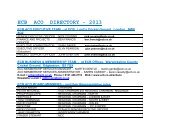
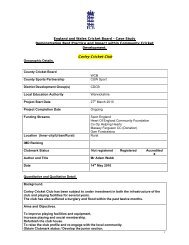
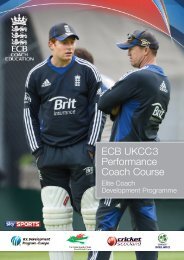

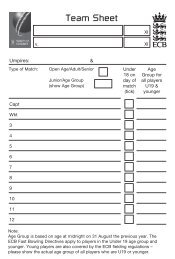
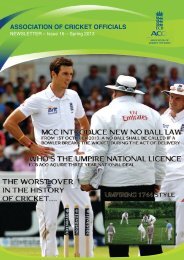

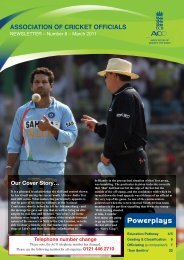

![Indoor Sports Halls with Cricket Provision [TS3] - Ecb - England and ...](https://img.yumpu.com/49070696/1/190x135/indoor-sports-halls-with-cricket-provision-ts3-ecb-england-and-.jpg?quality=85)



